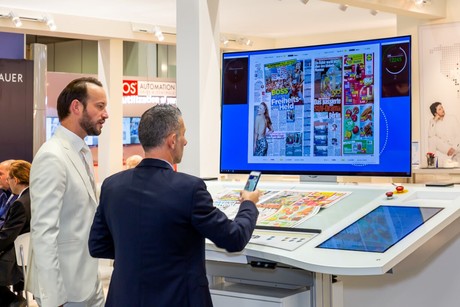WAN-IFRA: Could you describe in a few words what the core activities of ETDE are?
PAUL DRUESNE: As the Energy and Service Branch of Bouygues Construction, ETDE invents, implements, maintains and operates energy solutions and local services to ensure the sustainable performance of equipments and infrastructures. ETDE provides a full range of expertise, during project preparation and post-project phases in three spheres of activity:
- Network Infrastructure (Energy and Telecoms)
- Electrical, Mechanical and HVAC (Heating, Ventilation, and Air Conditioning) Engineering
- Facilities Management
WAN-IFRA: If a newspaper printing company wants to reduce its energy usage and costs, would ETDE be the right company to address for consulting? What procedure would you suggest for this project?
P. DRUESNE: Consultancy for energy optimization is the typical first step in our partnership with a printing company. Reducing energy consumption in a presshall is not an isolated issue: the complete printing process and infrastructure must be taken into account to provide long term solutions meeting our client’s strategy and equipment requirements. After a first meeting and visit of the plant, the procedure would start with a Project Development Agreement (PDA) between the printing company and ETDE stating technical and/or financial objectives to reach. Then ETDE would provide a detailed study to meet the challenges and provide concrete and effective solutions. Next, if ETDE can provide solutions to meet PDA objectives the printing company will have the choice to keep the study and end the partnership at this engineering phases or decide to continue the project with ETDE installing proposed solutions. After the project, maintenance service can also be provided on the long term. In every case, the earlier we work with the client, the better our solutions will be.
WAN-IFRA: How long would it take and how much would it cost to analyze the energy usage of the plant and to create a concept for improving efficiency?
P. DRUESNE: The work from the first meeting to a full technical solution proposed as a study can take from a few weeks to a few months depending on the existing printing plant facility, its equipment, its usage, its environment. ETDE is establishing long term partnerships with its clients: our objective is to install and maintain the technical solution we design. In other words, the cost of the study itself would ideally be part of a full turnkey solution. If our client wants to keep the study as a design solution only, it would cost him from 5% to 7% of the price of the operational solution fully installed by ETDE (provided that the study meets PDA defined criteria).
WAN-IFRA: Is energy contracting a model that could also be applied for a newspaper printing plant?
P. DRUESNE: With increasing energy cost and tough competition on the news edition market, energy consumption is one of the main subjects of lean production and is becoming a burning issue in printing industry. When it’s not already the case, we definitely think that energy contracting will be the best option for printing companies in the coming years.
WAN-IFRA: What are the possibilities to reuse lost energy, for example heat?
P. DRUESNE: Classic re-use of energy (cogeneration) is possible but still limited. Well designed print plants operate on almost constant cooling with minimal heating requirement. For example it is possible to collect lost heat and use it to heat domestic/office hot water. Then every plant specificity in energy can be a potential source of loss, our job is to determine whether it can be collected and if it worth the investment.
WAN-IFRA: How much of energy costs can be saved through facility management?
P. DRUESNE: FM can be optimized to make global operational cost savings which include energy savings. An efficient Building Management System is also an important factor in FM.
The surprising fact in most print plants that we have looked at is that typically 80% of the plant energy use is involved with lighting, HVAC etc and only 20% on production equipment, the press / mailroom etc. It tends to be these areas where the largest savings can be made via the use of variable speed drives, free cooling etc.
WAN-IFRA: Aren’t printing plants with their large roofs ideal for photovoltaic installations? Would such an investment pay off (within a reasonable time)?
P. DRUESNE: Likewise many other infrastructures, photovoltaic installation on printing plants roof could be a good option provided the plant is installed in a sunny region. To handle an investment for such innovation we would consider new business models and partnership with local electricity providers. ETDE is familiar with photovoltaic farms installations but haven’t tried it on press halls so far. Return over investment will also depend on the country policy for buying back locally produced green energy.
WAN-IFRA: What needs to be considered regarding energy efficiency when a new printing facility is planned?
P. DRUESNE:
- HVAC design to be energy efficient at part load conditions as many orienting plants still operate their presses 6 hours per 24h day.
- Workflow process
- Plant area
- Facility space utilization
- Printing process equipment requirements
- Attached office configuration
- Local energy available sources
- Plant general environment (Weather, neighbors, natural resources,…)
…
WAN-IFRA: Has ETDE done projects in the area of newspaper printing (if yes, which newspapers)?
P. DRUESNE: Yes, many, including:
- DC Thomson – Dundee and Glasgow,
- Newsquest at Weymouth / Glasgow / Oxford.
- The Guardian – Manchester,
- News International – Eurocentral,
- Daily Mail DGMT – Didcot, Stoke-on Trent,
- Leicester, Bristol etc.
We are currently working with Westferry Printers as their M&E (Mechanical and Electrical) expert in their project to move from their historical London-based plant to a new printing facility in Luton.



